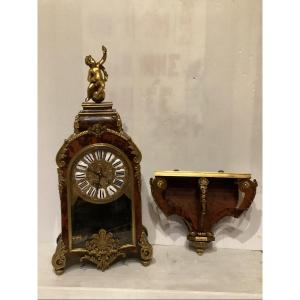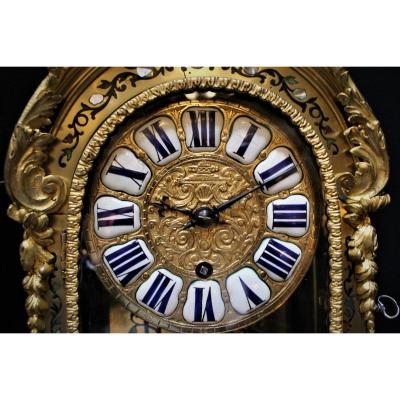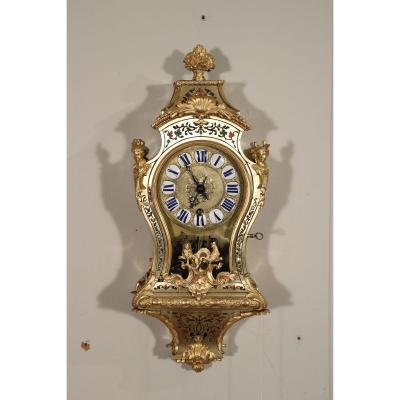The clock displays all the design characteristics of Louis XIV period style, starting with its shape. This one is rounded on the top, straight for the uprights connected by a volute to end with a slight curve at the level of the feet.
The chiseled gilded bronze dial indicates the minutes in arabian indexes as well as dark blue enameled hour markers in roman indexes . 4 adjustment positions are seen on number XII.
Fine original blues steel hands. The escapement has been modified from its original crownwheel to a anchor type with a heavy and ajustable pendulum keeping very accurate time.
By pulling a cord on the side, it rings on demand the quarts on three bells also known as "cartel d'alcove" usually located in music or quiet rooms not to disturb..
The whole clock is covered with Boulle marquetry over a brown tortoiseshell background and fine brass inlays with engravings. The rear door which gives access to the movement features a remarkable marquetry design patterns with figures of grotesques inspired by Berain or BVRB repeated both on the interior side and in counterpart (tortoiseshell on a brass background) on the exterior side.
This unique "double" cut marquetry is seen on the most prestigious timepieces that were displayed by Aristocrates in the middle of the castle rooms on pedestrals. The rich ornulu trim design of this cartel is composed of an antic lamp on top (very specific of the workshops of André Charles BOULLE), crown king pediment, lower part of the dial signed THURET, aries hoof feet, folliages, palms.
A very similar cartel clock signed from Thuret is documented on book "La Pendule Française du Moyen Âge au XXème siècle " by Pierre Kjellberg - page 42 - figure A - very similar Louis XIV clock design with movement by THURET, in Versailles library.
Reference:
- Dictionary of French clockmakers-Tardy- Thuret Isaac recorded as Watchmaker of King Louis XIV - ca 1684.




































 Le Magazine de PROANTIC
Le Magazine de PROANTIC TRÉSORS Magazine
TRÉSORS Magazine Rivista Artiquariato
Rivista Artiquariato